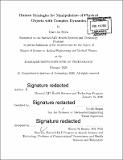| dc.contributor.advisor | Neville Hogan. | en_US |
| dc.contributor.author | Da Silva, Davi(Davi Eric) | en_US |
| dc.contributor.other | Harvard--MIT Program in Health Sciences and Technology. | en_US |
| dc.date.accessioned | 2020-10-18T21:48:33Z | |
| dc.date.available | 2020-10-18T21:48:33Z | |
| dc.date.copyright | 2020 | en_US |
| dc.date.issued | 2020 | en_US |
| dc.identifier.uri | https://hdl.handle.net/1721.1/128082 | |
| dc.description | Thesis: S.M., Harvard-MIT Program in Health Sciences and Technology, 2020 | en_US |
| dc.description | Cataloged from PDF version of thesis. | en_US |
| dc.description | Includes bibliographical references (pages 83-88). | en_US |
| dc.description.abstract | Humans are adept at manipulating objects to perform a task, including objects with their own complex dynamics, such as a sloshing cup of coffee or cracking a whip. Humans regularly outperform machines at such physical interaction tasks, in spite of the inferiority of humans' actuation systems. It is therefore of interest to understand what controller or controllers humans use to achieve this proficiency. One major set of hypotheses for human control are derived from optimization theory-that subjects choose trajectories that minimize the time integral of some quantity (such as mean square jerk) across the movement. These hypotheses are appealing for their mathematical simplicity, as they reduce to ordinary differential equations. Another set of hypotheses, however, posits that humans exhibit proficiency in motor tasks by constructing all movements as a superposition of a few smaller "submovements" of a stereotyped shape. Little work has been done investigating what hypothesis best describes human movement in interaction tasks, especially in fast-moving actions where humans' capacity for feedback control is limited. To that end, we used an experimental paradigm where subjects manipulated a virtual cart-pendulum system with the goal of moving it from one position to another while minimizing the residual oscillation of the pendulum at the end of the trial. Experimental velocity trajectories were then decomposed into sums of finite-support lognormal curves to infer what submovements may have been used by the subject to construct the movements. Quantitative information about submovement shape and subjects' movement strategies overall were then extracted from the decompositions. The trajectories themselves were also compared to three models: minimum object crackle (MCO), dynamically constrained minimum jerk of the hand (DCMJH), and input shaping (IS). The former are optimization-based hypotheses, and the latter is more readily compatible with the submovement hypothesis | en_US |
| dc.description.statementofresponsibility | by Davi da Silva. | en_US |
| dc.format.extent | 88 pages | en_US |
| dc.language.iso | eng | en_US |
| dc.publisher | Massachusetts Institute of Technology | en_US |
| dc.rights | MIT theses may be protected by copyright. Please reuse MIT thesis content according to the MIT Libraries Permissions Policy, which is available through the URL provided. | en_US |
| dc.rights.uri | http://dspace.mit.edu/handle/1721.1/7582 | en_US |
| dc.subject | Harvard--MIT Program in Health Sciences and Technology. | en_US |
| dc.title | Human strategies for manipulation of physical objects with complex dynamics | en_US |
| dc.type | Thesis | en_US |
| dc.description.degree | S.M. | en_US |
| dc.contributor.department | Harvard University--MIT Division of Health Sciences and Technology | en_US |
| dc.identifier.oclc | 1199299962 | en_US |
| dc.description.collection | S.M. Harvard-MIT Program in Health Sciences and Technology | en_US |
| dspace.imported | 2020-10-18T21:48:29Z | en_US |
| mit.thesis.degree | Master | en_US |
| mit.thesis.department | HST | en_US |
